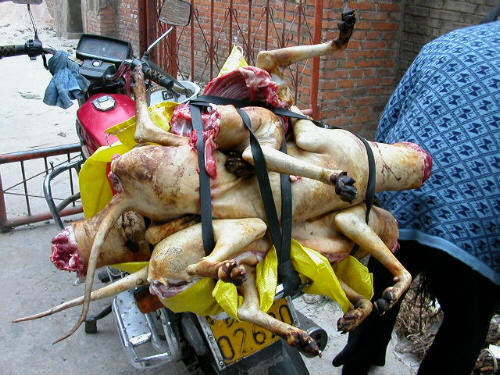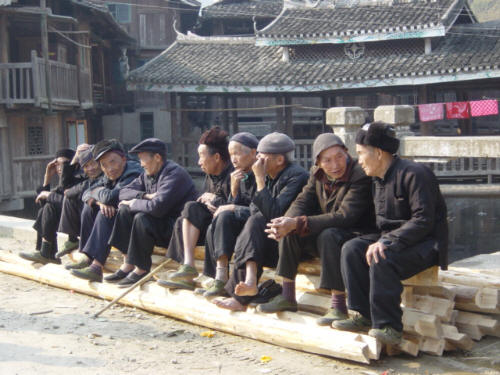Changzhou Chronicle Pt. 10
![]()
January 2004
As time passes and the end of my Chinese contract is getting closer, I find myself with too many things to do and too little spare time. So it took me one month to translate CC Pt.10 into English (I’m doing it on the plane to Italy for a Fiat GRA.DE week in Turin). It’s strange to be writing about my Xmas trip in the middle of February…
As usual, I spent my holidays in China, this time looking for a milder climate and discovering some new minorities.
Because of my curiosity about some remote areas of this country and my travel mate’s dislike of classic tourism, it ended up by being a very adventurous trip.
In 20 days we covered 3 areas: South-Eastern Guizhou, the Nort-West of Yunnan and Xishuangbanna, the tropical region at the border with Burma and Laos.
We visited many local markets, observed peculiar hair-styles (distinctive of each minority: Miao, Dong, Naxi, Dai, Bulang, Laohu,…), trekked both in the cool Tiger Leaping Gorge (at the source of the Yang-tze) and in the hot tropical forest of Damenlong, fell in love with a couple of breathtaking villages like Xijiang and Shitoucheng, forgot about New Year because nobody around us seemed to care and managed to never spend 2 nights in the same place. Our trip ended with a total of 86 hours of bus, 12 of train and 7 of airplane.
For a more detailed photographic account of the journey, visit the sections Guizhou and Yunnan.
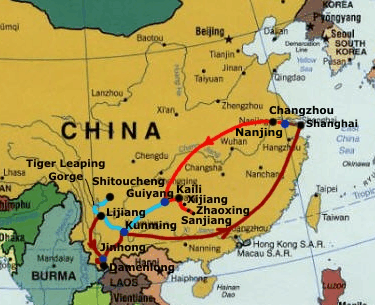
Part 1: Guizhou & Guangxi
The town of Kaili is the gateway to the remote villages of South-Eastern Guizhou. 2 things of Kaili immediately strike the Westerner. The first is the hairdo of the women from the different villages: the hair is long and black, gathered in a bun and fixed by a coloured plastic comb, or a metal arrow, bows or fake flowers.
The second striking thing is the specialty of Kaili’s restaurants: dog meat.
After one year in China, the view of stiff, dead dogs on sale in the markets doesn’t surprise me anymore. Nonetheless, the experience of the dog market/slaughterhouse in Kaili left me shaken.
You will find the pictures in a special section of the website (click here ;but I recommend to keep away from it if you are sensitive and like dogs).
Despite its reputation as the biggest Miao village in the world, Xijiang has only one guesthouse. When we arrived after dark, the owner of the guesthouse saved us from starvation (apparently after 7.00 pm there was no place to eat and no light in the streets).
Thanks to her Miao hospitality, we had some rice with eggs and warmed up around the stove of her 1 room flat, before going to sleep at 9.00 pm in our freezing room. I should say: before TRYING to sleep, since some crackling loudspeakers were broadcasting speeches and martial hymns throughout the village. It wouldn’t be the only time we experience that during this trip: apparently it’s one of the Party’s ways to control remote villages.
The next morning we woke up at the sound of the National Anthem, but our mood got better as soon as we looked out of the window: the view was stunning, with dark, wooden houses in the mist, among terraced hills and rice paddies.
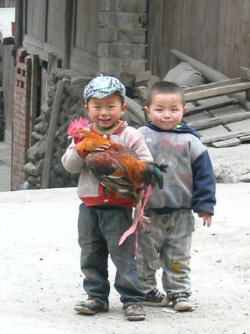
While we were walking around the village, a group of local women invited us into their house. We all sat on stools around the fire (the room didn’t have any other furniture) and slowly the house filled up with curious people. Unfortunately the conversation faded shortly after (my Chinese has not improved from the survival level), so after exchanging information about everybody‘s age we said goodbye to the crowd.
You won’t find tiny Pan Lao on Guizhou maps. We ended up there in the attempt to reach Zhaoxing in only one day from Kaili. We caught a glimpse of a couple of houses before darkness and the number of children in the street seemed out of proportion.
The reason for that was soon discovered: while we were strolling in the darkness in Pan Lao’s only street (after having found 2 beds for the night for 0,5EUR each), the English teacher of the local school intercepted us. He explained that the school of Pan Lao has more than 700 students from the nearby villages and that most of them also stay in Pan Lao overnight. He invited us to visit a couple of his classes (they have lessons until 9.00 pm) and so we headed for the school, among a crowd of exultant, excited kids. The 2 classes we visited are of approximately 50 pupils each, aged 12 to 17. The pupils were fascinated by Fred’s journey (he has been travelling around the world by boat and bicycle and has already cycled 25,000 km) and we even went through a session of autograph signing, having become local celebrities.
school in Pan Lao
From the walls of the classrooms Mao and Deng Xiao Ping looked on us and we got further proof of the rural environment we found ourselves in when one girl asked spontaneously whether Fred and I were married. Just as I started answering “no”, the teacher hastily interrupted, whispering to us “Don’t say: it’s a secret!”. Nobody seemed to mind that the question remained unanswered and the next question was the same old: “How can we improve our English”?
After the biggest Miao village (Xijiang) we made it to the biggest Dong settlement: Zhaoxing. It’s another stunning village, but instead of the corn of Xijiang, here there was radish and blue cloth hanging from the windows.
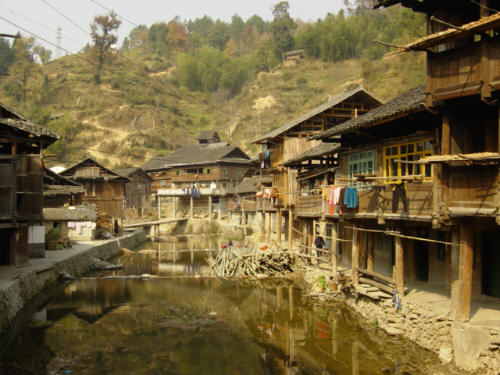
We were lucky to see ZX in a splendid light, on a very clear day. We hiked in the surroundings, among terraces and rice paddies.
Fleetingly in the Guangxi Province in order to see the famous village of Chengyang. We were disappointed by its touristy atmosphere, but the road to reach Sanjiang is breathtaking, so we had no regrets. For a couple of hours the bus drove along the Duliun River and on the other side of the river, which can be reached only by boat, there are some very nice villages. To keep in mind for a future trip…
Part 2: Northern Yunnan
After one year here I was again in this nice Naxi town. This time the Snow Mountains were in full view, but we felt uncomfortable among the hoards of tourists and the souvenir shops. We had to leave the touristy area to enjoy the old houses, the snowy peaks, and the bright blue skies.
The local market is huge and for 0,5 EUR we bought one form of delicious goat cheese. Despite the tourists, the main place of Lijiang was still the meeting point for the old local people, dressed in their traditional Naxi clothes: they play cards, chat and dance their traditional dances.
Naxi women dancing on the main square in Lijiang
The trail through Tiger Leaping Gorge begins in Qiaotou (2 hours North of Lijiang), where the women wear big, rectangular black hats. TLG is the most spectacular gorge of the Yangtze River and the trail from Qiaotou to Daju is approximately 50 km. We walked for two days, stopping halfway at Sean’s Guesthouse, where we had some delicious yak cheese and enjoyed the spectacular view of the surrounding mountains. Very nice trek.
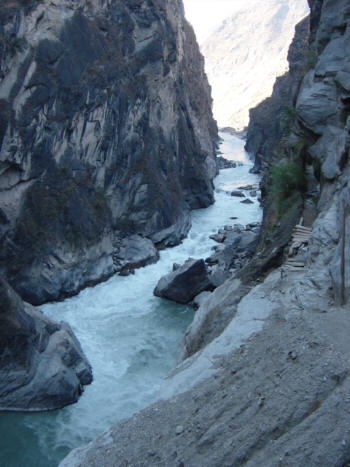

In Daju, where we arrived on the second day, we landed in the middle of a wedding celebration. The atmosphere was joyful, the old and the young were dancing together in a circle, with a flutist in the centre, together with the kids. The monotonous Naxi music would stick in our brains for the next days.
It took us more than 7 hours for the 150 km to Baoshan, North-East of Lijiang. The road was in terrible conditions and we changed 3 buses. The last one was completely full and while Fred sat in the front trying to survive a crowd of smokers, loud folk music and stinky pigs in sacks on the floor of the bus, I was in the back, enjoying the company of my neighbour, a lady who spat from the window every 2 minutes and vomited, for a change, every half hour. The vomit created an interesting pattern on her coat and on the external side of the bus… To spare time and energy in this intense activity, she kept the window open all the time, so that I was freezing all the way to Baoshan.
Luckily, the spectacular view distracted us from our immediate surroundings: the snowy peaks of the Snow Mountains were gradually substituted by a green-brown landscape, with big terraced valleys and wooden houses. It was a wonderfully clear day.
When we reached Shitoucheng in the afternoon, the valley was already in the shade of the mountains, but we had enough time before darkness to appreciate the uniqueness of this village, built on the rocks and accessible only on foot.
Shitoucheng
We descended from the road, entering its cobbled, narrow streets, among children and donkeys. The valley was breathtaking, with the Yangtze on the bottom, terraced mountains and another spectacular gorge on the right.
Every now and then we heard a loud shot and when we got to the entrance of the fortified part of the village, we discovered the origin of it: it was a popcorn machine! A thick cylinder is filled with corn and heated. When they open it, there is a loud explosion and all the popcorn flies onto the floor. Then it is gathered with a broom and transferred to a sack.
We slept in the only guesthouse of the old village (750 years ago Genghis Khan arrived in Shitoucheng and they were celebrating the anniversary). We had a wonderful view on the valley and on the village, and we spent the last evening of 2003 chatting with the Naxi owner.
Part 3: Xishuangbanna
Xishuangbanna is the South-West corner of Yunnan, bordering with Burma, Laos and Vietnam. We went there with the intention to enjoy some warm weather before going back to Changzhou’s freezing winter.
The population of this part of China is mainly Dai (derived from Thais) but this area offers a very interesting mix of ethnic groups, colours and sounds.
We concentrated on the area at the border with Myanmar.
Another couple of days of trekking, this time in tropical climate, wearing T-shirts.
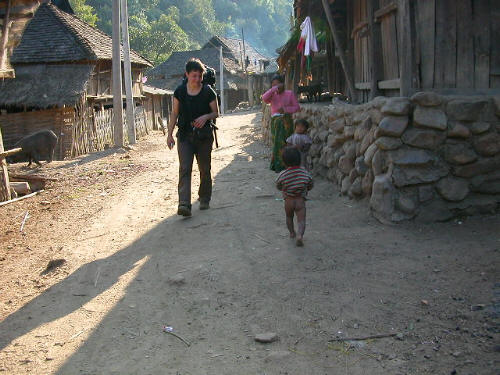
The trail lead us through villages with wooden houses on piles.
The woods are being exploited and the panorama around us was quite bare and sad at the beginning, but the more we moved away from Damenlong, the more we entered the tropical forest. Songeer, the Laohu village where we spent the first night, counts about 80 inhabitants and is in the middle of the jungle, on the river.
We slept in the biggest and most central house of the village – on piles – and soon realized that it functioned also as local shop and entertainment centre (in a corner we spotted a TV and a karaoke set).
The family who lived there have 2 kids. The house consisted of just one big room, with a fireplace in the centre. They slept on the floor, in the corners of the room. Nature was the toilet and the food was very poor (rice and some kind of boiled pumpkin). The meals seemed to have a ritual: the guests (us) ate first, then the head of the family and only in the end the other members. The father took the skull of a pig and broke it, offering us the brain. Politely, we declined.
Conversation was very limited and very soon we realized that despite the early time (20:30), we were the only house with the lights still on.
Songeer (the house in the center is where we slept)
The following morning, after a breakfast that was a repetition of last night’s dinner and after a short demonstration of the karaoke set, we said goodbye to the family and left. We reached Weidong, a bigger village where donkeys, dogs, pigs and turkeys seemed to be the only inhabitants: the streets were deserted.
In a surreal atmosphere, the air was filled with the soundtrack of a Hong Kong action movie, coming from some huge loudspeakers in the centre of the village.
At the exit of the village we finally found all its population, gathered around a basketball field, where the girls were playing a match, while the men were watching amused. The old women were knitting nets and the kids were running for the ball whenever it was thrown out of the field, down the hill.
In the afternoon we exited the forest and witnessed once again the appalling state of deforestation of this area.
We reached Bulangshan at sunset and slept in the shabbiest place I have ever experienced: for 0,5 EUR we got a wooden shack, used for the storage of tools. We were very happy to have our sleeping bags with us!
Accomodation in Bulangshan
Moreover, one of the neighbour shacks harboured the karaoke of the village: its noise mixed with the broadcast from the village radio (like in Xijiang). The latter would wake us up at 6:30 the next morning. Funnily enough, the public toilet was in the courtyard of the local police station.
The last couple of days we took it easy, since we started to suffer from the previous hectic 18 days.
On the last day, while we were trying to reach the Mekong River through rice paddies, Fred ‘landed’ in one of them, sinking to his knees. Our trip ended in a carwash, rinsing Fred’s jeans and shoes.
On the 6th of January we took the sleeper bus from Jinhong to Kunming; then the plane to Shanghai and the train to Changzhou. After 27 hours we were back in the Mingdu …
Links: more pics of Guizhou e Yunnan
| CC Part 9 | CC Index | CC Part 11 | ||
